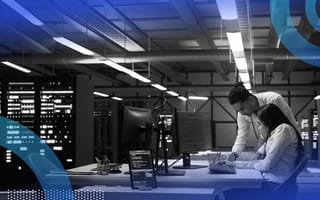As artificial intelligence systems scale across industries, conversations often center around data, models, and compute. With global AI spending projected to hit $632 billion by 2028 (IDC), it's clear that AI is becoming central to business and innovation.
But every breakthrough in AI depends on a very physical world: racks of GPUs, power-hungry infrastructure, and edge devices deployed in unpredictable environments.
In this rush to innovate, physical security is often an afterthought, and that’s a mistake
5 Risks of AI Physical Security
- Outdated security assessments leave critical infrastructure exposed.
- Excessive access creates opportunities for a breach.
- Internal zones lack protection.
- Utility and support rooms are soft targets.
- Safety and security still operates in silos.
From unauthorized access to hardware theft or equipment tampering, physical security lapses can quietly erode performance, trigger downtime, or compromise sensitive operations.
Here are five common blind spots and how they pose a growing risk to AI’s future.
1. Outdated Security Assessments Leave Critical Infrastructure Exposed
AI data centers are anything but static. Workloads shift. Racks are reconfigured. New hardware rolls in constantly. Yet many facilities are still evaluated using outdated checklists built for slower, more predictable environments.
This disconnect between today’s fast-moving AI infrastructure and legacy assessment methods stems from a mix of institutional inertia, the rapid pace of change, and the uniquely complex demands of AI workloads.
Consider your last major tech or security rollout. Chances are, the layout shifted midway, equipment arrived ahead of schedule, and temporary workarounds became permanent fixtures.
When security assessments fail to account for temporary access points, evolving floor plans or new staging zones, they leave room for serious vulnerabilities.
Physical Security Tip
Ditch the static checklist. Conduct dynamic, site-specific walkthroughs that focus on non-obvious risk areas like rooftop units, cable pathways and loading bays, the places most likely to fall outside traditional security perimeters.
2. Excessive Access Creates Opportunities for Breach
As AI infrastructure grows, so does the number of people who interact with it, from facilities teams and robotics engineers to third-party contractors. Roughly 40 percent of data center outages are caused by human error, a risk that rises as more hands touch critical systems.
Yet many organizations still rely on shared credentials, outdated badge systems or blanket access rights that grant more permission than necessary. The result is a lack of visibility and an increasingly vulnerable attack surface.
How Security Teams Can Strengthen Access Control
Segment access by role, zone, and time of day. Tie credentials to real-time logging and automated alerts. Use anti-tailgating measures at high-value entry points. And routinely audit vendor access procedures, especially in dynamic AI environments where staffing and equipment shift often.
3. Internal Zones Lack Protection
Perimeter security matters, but it’s not enough. AI hardware, such as GPU clusters, custom servers and specialized networking gear, is often housed in interior zones that lack the same level of oversight.
These areas may go unmonitored or unsecured simply because they’re assumed to be safe once inside the front door. But that assumption creates blind spots and introduces risk.
An unprotected rack becomes an easy target for theft, tampering, or unauthorized access. Even a small change, such as a swapped cable or unlogged reconfiguration, can degrade model performance, introduce downtime, or compromise sensitive workloads.
Physical Security Best Practice
Treat every cabinet, rack, and staging area as a critical asset. Use locking enclosures, tamper-evident seals, and rack-level access logs. Physical access should be as tightly controlled and auditable as your digital systems.
4. Utility and Support Rooms Are Soft Targets
AI workloads generate a significant amount of heat. Cooling systems, HVAC closet and power distribution units (PDUs) are essential to maintaining a stable environment.
A single high-end AI processor like an NVIDIA H100 or B200 can consume between 700 and 1,200 watts under full load. For perspective, that’s more than a typical residential microwave running at maximum power.
Yet these utility spaces are often overlooked when it comes to physical security.
Labeled as low risk or out of scope, they’re frequently left unsecured or lightly monitored, despite playing a critical role in uptime and performance.
A compromised cooling system or tripped PDU can bring down entire racks. And it doesn’t take a cyberattack to make that happen. A single act of unauthorized maintenance or accidental damage in one of these areas can trigger cascading failures across a high-density deployment.
Critical Infrastructure Insight
Treat mechanical rooms like mission-critical zones. Install motion-triggered surveillance, control access with clear audit trails, and make sure maintenance activities are logged as carefully as server room activity.
5. Safety and Security Still Operate in Silos
In many organizations, security teams monitor access control and intrusion detection, while safety teams manage fire systems and emergency protocols. But when these systems operate in isolation, response times suffer, and so does resilience.
A lack of integration doesn’t just slow things down; it puts people and infrastructure at risk.
During a real emergency, fragmented protocols can lead to missed handoffs, delayed reactions, or confusion about who’s in charge. In AI environments where continuity is critical, even a short delay can escalate into a full-blown outage.
Operational Resilience Tip
Unify safety and security systems wherever possible. Connect access control, emergency alerts and fire suppression platforms so they speak the same language. Just as important, run joint drills across departments to ensure alignment long before anything goes wrong.
AI Innovation Depends on Physical Integrity
AI systems may run in the cloud, but they depend on physical spaces, hardware, and people. If the physical layer is overlooked, digital safeguards often aren’t enough to catch the gaps.
As AI becomes increasingly integrated into business operations and daily life, physical security can no longer be an afterthought. It has to be part of the foundation.
Because without securing the physical layer, everything else is built on uncertainty.





